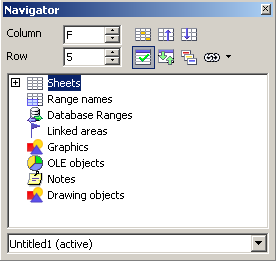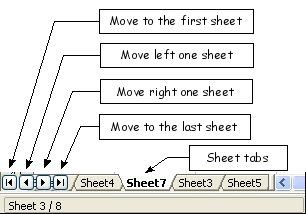Difference between revisions of "Documentation/OOoAuthors User Manual/Calc Guide/Introducing Calc"
(No difference)
| |
Revision as of 14:52, 10 July 2007
This is Chapter 1 of OpenOffice.org 2.x Calc, produced by the OOoAuthors group. A PDF of this chapter is available from the OOoAuthors Guides page at OpenOffice.org.
<< User Manuals page
<< Calc Guide Table of Contents
Chapter 2 Entering, Editing, and Formating Data >>
Contents
What is Calc?
Calc is the spreadsheet component of OpenOffice.org (OOo). You can enter data, usually numerical data, in a spreadsheet and then manipulate this data to produce certain results.
Alternatively you can enter data and then use Calc in a 'What If...' manner by changing some of the data and observing the results without having to retype the entire spreadsheet or sheet.
A major advantage of electronic spreadsheets is that the data is easier to alter. If the correct functions and formulas have been used, the program will apply these changes automatically.
Spreadsheets, sheets and cells
Calc works with elements called spreadsheets. Spreadsheets consist of a number of individual sheets, each containing a block of cells arranged in rows and columns.
These cells hold the individual elements—text, numbers, formulas etc.—which make up the data to be displayed and manipulated.
Each spreadsheet can have many sheets and each sheet can have many individual cells. Each sheet in Calc can have a maximum of 65,536 rows and a maximum of 245 columns (A through IV). This gives 16,056,320 individual cells per sheet.
Parts of the main Calc window
When Calc is started, the main window looks similar to Figure 1.
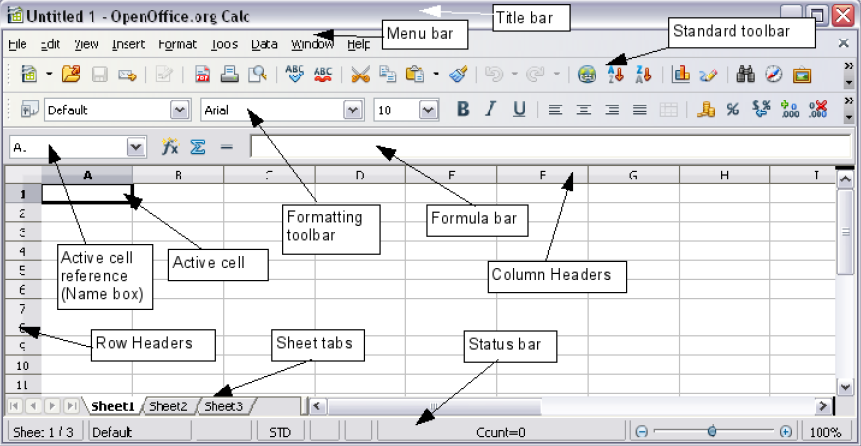
Figure 1: Parts of the Calc window.
Title bar and Menu bar
The Title bar, at the top, shows the name of the current spreadsheet. If the spreadsheet is new, then its name is Untitled X, with X being a number. When you save a new spreadsheet for the first time, you will be prompted to enter a name.
Under the Title bar is the Menu bar. When you choose one of the menus, a submenu appears with other options. The Menu bar can be modified, as discussed in Chapter 4 (Menus and Toolbars) in the Getting Started guide.
Toolbars
Under the Menu bar by default are three toolbars: the Standard toolbar, the Formatting toolbar, and the Formula bar.
The icons on these toolbars provide a wide range of common commands and functions. The toolbars can be modified, as discussed in Chapter 4 (Menus and Toolbars) in the Getting Started guide.
Placing the mouse pointer over any of the icons displays a small box, called a tooltip. It gives a brief explanation of the icon's function. For a more detailed explanation, select Help > What's This? and hover the mouse pointer over the icon.
In the Formatting toolbar, there are two rectangular areas on the left. They are the Font Name and Font Size menus. (See Figure 2.) If there is something already in the box, it tells what the current setting for the selected area is.
- inline:Frame2.png
Click the little button with an inverted triangle to the right of the box to open a menu. From the Font Name and Font Size menus, you can change the font and its size in selected cells.
Formula bar
On the left of the Formula bar (see Figure 3) is a small text box, called the Name box, with a letter and number combination in it, such as D7. This is the column letter and row number, called the cell reference, of the current cell.
To the right of the Name box are the the Function Wizard, Sum, and Function buttons.
Clicking the Function Wizard button opens a dialog box from which you can search through a list of available functions. This can be very useful, because it also shows how the functions are formatted.
The Sum button inserts a formula into the current cell that totals the numbers in the cells above, or to the left if there are no numbers above, the current cell.
The Function button inserts an equals sign into the selected cell and the Input Line, thereby setting the cell ready to accept a formula.
When you enter data into a cell, the Sum and Equals buttons change to Cancel and Accept buttons. ![]()
The contents of the current cell (data, formula, or function) are displayed in the Input Line, the remainder of the Formula bar. You can edit the cell contents of the current cell in the Input Line, or you can do that in the current cell. To edit inside the Input Line area, left-click the appropriate part of the Input Line area, then type your changes. To edit within the current cell, double-click the cell.
Individual cells
The main section of the screen displays the individual cells in the form of a grid, with each cell being at the intersection of a particular column and row.
At the top of the columns and at the left-hand end of the rows are a series of gray boxes containing letters and numbers. These are the column and row headers. The columns start at A and go on to the right and the rows start at 1 and go on down.
These column and row headers form the cell references that appear in the Sheet Area box on the Formula bar (see Figure 3). These headers can also be turned off by selecting View > Column & Row Headers.
Sheet tabs
At the bottom of the grid of cells are the sheet tabs (see Figure 4). These tabs enable access to each individual sheet, with the visible, or active, sheet having a white tab.
Clicking on another sheet tab displays that sheet and its tab turns white. You can also select multiple sheet tabs at once by holding down the Control key while you click the names.
File management
Starting new spreadsheets
A new spreadsheet can be opened regardless of which component of OOo you are using at the time. For example, a new spreadsheet can be opened from Writer or Draw.
From the menu bar
Click File and then select New > Spreadsheet.
From the toolbar
Use the New Document ![]() button on the Standard toolbar. Click the drop-down arrow for a choice of what type of document to open (text document, spreadsheet, and so on). Click the button itself to create a new document of the type that is currently open (if a spreadsheet is open, a new spreadsheet document will be created).
button on the Standard toolbar. Click the drop-down arrow for a choice of what type of document to open (text document, spreadsheet, and so on). Click the button itself to create a new document of the type that is currently open (if a spreadsheet is open, a new spreadsheet document will be created).
From the keyboard
If you already have a spreadsheet open, you can press Control+N to open a new spreadsheet.
From a template
Calc documents can also be created from templates, if you have any spreadsheet templates available. Follow the above procedures, but instead of selecting Spreadsheet from the File menu, select Templates and Documents. On the Templates and Documents window, navigate to the appropriate folder and double-click on the required template. A new spreadsheet, based on the selected template, opens.
Opening existing spreadsheets
A spreadsheet can also be opened no matter what component of OOo you are in.
From the menu bar
Click File and then select Open.
From the toolbar
Click the Open button ![]() on the Standard toolbar.
on the Standard toolbar.
From the keyboard
Use the key combination Control+O.
Each of these options displays the Open dialog box (Figure 5), where you can locate the spreadsheet that you want to open.
- inline:Frame12.png
Tip: You can also open a spreadsheet that has been recently worked on, by using the Recently Opened Files list. This list can be accessed from the File menu, directly below Open. The list displays the last 10 files that were opened in any of the OOo components.
Saving spreadsheets
Spreadsheets can be saved in three ways.
From the menu bar
Click File and then select Save.
From the toolbar
Click on the Save button ![]() on the Function bar. This button will be greyed-out and unselectable if the file has been saved and no subsequent changes have been made.
on the Function bar. This button will be greyed-out and unselectable if the file has been saved and no subsequent changes have been made.
From the keyboard
Use the key combination Control+S.
If the spreadsheet has not been saved previously, then each of these actions will open the Save As dialog box (Figure 6). Here you can specify the spreadsheet name and the location in which to save it.
- inline:Frame13.png
Note: If the spreadsheet has been previously saved, then saving will overwrite the existing copy without opening the Save As dialog box. If you want to save the spreadsheet in a different location or with a different name, then select File > Save As.
Going to a particular cell
Using the mouse
Place the mouse pointer over the cell and left-click.
Using a cell reference
Click on the little inverted black triangle just to the right of the Name box (Figure 3). The existing cell reference will be highlighted. Type the cell reference of the cell you want to go to and press Enter. Or just click into the Name box, backspace over the existing cell reference and type in the cell reference you want.
Using the Navigator
Click on the Navigator button ![]() in the Standard toolbar (or press F5) to display the Navigator. Type the cell reference into the top two fields, labeled Column and Row, and press Enter. In Figure 7 the Navigator would select cell F5.
in the Standard toolbar (or press F5) to display the Navigator. Type the cell reference into the top two fields, labeled Column and Row, and press Enter. In Figure 7 the Navigator would select cell F5.
Moving from cell to cell
In the spreadsheet, one cell, or a group of cells, normally has a darker black border. This black border indicates where the focus is (see Figure 8).
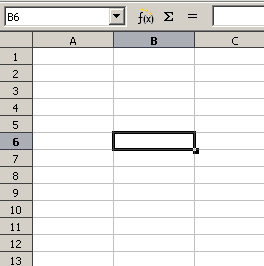
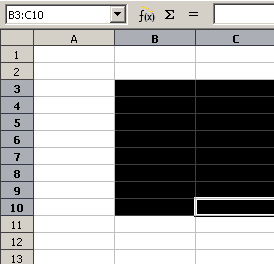
Figure 8. (Left) One selected cell and (right) a group of selected cells.
Using the Tab and Enter keys
- Pressing Enter or Shift+Enter moves the focus down or up, respectively.
Pressing Tab or Shift+Tab moves the focus right or left, respectively.
Using the cursor keys
Pressing the cursor keys on the keyboard moves the focus in the direction of the arrows.
Using Home, End, Page Up and Page Down
- Home moves the focus to the start of a row.
- End moves the focus to the column furthest to the right that contains data.
- Page Down moves the display down one complete screen and Page Up moves the display up one complete screen.
- Combinations of Control and Alt with Home, End, Page Down, Page Up, and the cursor keys move the focus of the current cell in other ways. Table 1 describes all the keyboard shortcuts for moving about a spreadsheet.
Tip: Holding down Alt+Cursor key resizes a cell.
Table 1. Moving from cell to cell using the keyboard
| Key Combination | Movement | |
| → | Right one cell | |
| ← | Left one cell | |
| ↑ | Up one cell | |
| ↓ | Down one cell | |
| Control+→ | To last column containing data in that row or to Column IV | |
| Control+← | To first column containing data in that row or to Column A | |
| Control+↑ | To first row containing data in that column or to Row 1 | |
| Control+↓ | To last row containing data in that column or to Row 32000 | |
| Control+Home | To Cell A1 | |
| Control+End | To lower right hand corner of the square area containing data | |
| Alt+PgDn | One screen to the right (if possible) | |
| Alt+PgUp | One screen to the left (if possible) | |
| Control+PgDn | One sheet to the right (in Sheet Tabs) | |
| Control+PgUp | One sheet to the left (in Sheet Tabs) | |
| Tab | To the cell on the right | |
| Shift+Tab | To the cell on the left | |
| Enter | Down one cells | |
| Shift+Enter | Up one cell |
Moving from sheet to sheet
Each sheet in a spreadsheet is independent of the others though they can be linked with references from one sheet to another. There are three ways to navigate between different sheets in a spreadsheet.
Using the keyboard
Pressing Control+PgDn moves one sheet to the right and pressing Control+PgUp moves one sheet to the left.
Using the mouse
Clicking one of the Sheet Tabs (see Figure 4) at the bottom of the spreadsheet selects that sheet.
If you have a lot of sheets, then some of the sheet tabs may be hidden behind the horizontal scroll bar at the bottom of the screen. If this is the case, then the four buttons at the left of the sheet tabs can move the tabs into view. Figure 9 shows how to do this.
Notice that the sheets here are not numbered in order. Sheet numbering is arbitrary—you can name a sheet as you wish.
Note: The sheet tab arrows that appear in Figure 9 only appear if you have some sheet tabs that can not be seen. Otherwise they will appear faded as in Figure 4.
Selecting items in a sheet or spreadsheet
Selecting cells
Cells can be selected in a variety of combinations and quantities.
Single cell
Left-click in the cell. The result will look like the left side of Figure 4. You can verify your selection by looking in the Name box.
Range of contiguous cells
A range of cells can be selected using the keyboard or the mouse.
To select a range of cells by dragging the mouse:
- Click in a cell.
- Press and hold down the left mouse button.
- Move the mouse around the screen.
- Once the desired block of cells is highlighted, release the left mouse button.
To select a range of cells without dragging the mouse:
- Click in the cell which is to be one corner of the range of cells.
- Move the mouse to the opposite corner of the range of cells.
- Hold down the Shift key and click.
To select a range of cells without using the mouse:
- Select the cell that will be one of the corners in the range of cells.
- While holding down the Shift key, use the cursor arrows to select the rest of the range.
The result of any of these methods will look like the right side of Figure 4.
Tip: You can also directly select a range of cells using the Name box. Click into the Name box as described in Using a cell reference. To select a range of cells, enter the cell reference for the upper left hand cell, followed by a colon (:), and then the lower right hand cell reference. For example, to select the range that would go from A3 to C6, you would enter A3:C6.
Range of non-contiguous cells
- Select the cell or range of cells using one of the methods above.
- Move the mouse pointer to the start of the next range or single cell.
- Hold down the Control key and click or click-and-drag to select a range.
- Repeat as necessary.
Selecting columns and rows
Entire columns and rows can be selected very quickly in OOo.
Single column or row
To select a single column, click on the column identifier letter (see Figure 1).
To select a single row, click on the row identifier number (see Figure 1).
Multiple columns or rows
To select multiple columns or rows that are contiguous:
- Click on the first column or row in the group.
- Hold down the Shift key.
- Click the last column or row in the group.
To select multiple columns or rows that are not contiguous:
- Click on the first column or row in the group.
- Hold down the Control key.
- Click on all of the subsequent columns or rows while holding down the Control key.
Entire sheet
To select the entire sheet, click on the small box between the A column header and the 1 row header (see Figure 10). You can also use the keyboard to select the entire sheet by pressing Control+A.
Selecting sheets
You can select either one or multiple sheets. It can be advantageous to select multiple sheets at times when you want to make changes to many sheets at once.
Single sheet
Click on the sheet tab for the sheet you want to select. The active sheet will become white (see Figure 4).
Multiple contiguous sheets
To select multiple contiguous sheets:
- Click on the sheet tab for the first sheet.
- Move the mouse pointer over the last sheet tab.
- Hold down the Shift key and click on the sheet tab.
All the tabs between these two sheets will turn white. Any actions that you perform will now affect all highlighted sheets.
Multiple non contiguous sheets
To select multiple non contiguous sheets:
- Click on the sheet tab for the first sheet.
- Move the mouse pointer over the second sheet tab.
- Hold down the Control key and click on the sheet tab.
- Repeat as necessary.
The selected tabs will turn white. Any actions that you perform will now affect all highlighted sheets.
All sheets
Right-click over any one of the sheet tabs and select Select All Sheets from the pop-up menu.
Working with columns and rows
Inserting columns and rows
Columns and rows can be inserted in several different way and quantities.
Single column or row
A single column or row can be added using the Insert menu:
- Select the column or rows where you want the new column or row inserted.
- Select either Insert > Columns or Insert > Rows.
Note: A single new column is inserted to the left of the highlighted column. A single new row is inserted above the highlighted row.
A single column or row can also be added using the mouse:
- Select the column or rows where you want the new column or row inserted.
- Right-click the header.
- Select Insert Rows or Insert Columns.
Multiple columns or rows
Multiple columns or rows can be inserted at once rather than inserting them one at a time.
- Highlight the required number of columns or rows by holding down the left mouse button on the first one and then dragging across the required number of identifiers.
- Proceed as for inserting a single column or row above.
Deleting columns and rows
Columns and rows can be deleted individually or in groups.
Single column or row
A single column or row can only be deleted by using the mouse:
- Select the column or row to be deleted.
- Right-click on the column or row header.
- Select Delete Column or Delete Row from the pop-up menu.
Multiple columns or rows
Multiple columns or rows can be deleted at once rather than deleting them one at a time.
- Highlight the required number of columns or rows by holding down the left mouse button on the first one and then dragging across the required number of identifiers.
- Proceed as for deleting a single column or row above.
Working with sheets
Like any other Calc element, sheets can be inserted, deleted and renamed.
Inserting new sheets
There are many ways to insert a new sheet. The first step for all of the methods is to select the sheets that the new sheet will be inserted next to. Then any of the following options can be used.
- Click on the Insert menu and select Sheet, or
- Right-click on its tab and select Insert Sheet, or
- Click into an empty space at the end of the line of sheet tabs (see Figure 11).

Figure 11. Inserting a new sheet
Each method will open the Insert Sheet dialog box (Figure 12). Here you can select whether the new sheet is to go before or after the selected sheet and how many sheets you want to insert. If you are inserting only one sheet, there is the opportunity to give the sheet a name.
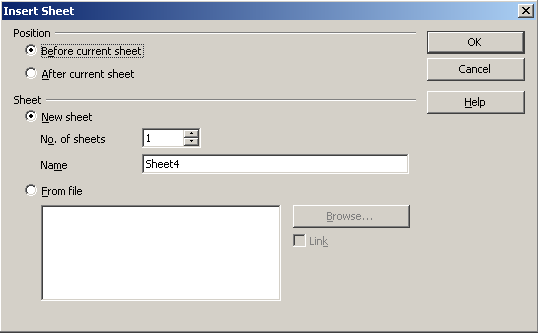
Figure 9. Insert Sheet dialog box.
Deleting sheets
Sheets can be deleted individually or in groups.
Single sheet
Right-click on the tab of the sheet you want to delete and select Delete Sheet from the pop-up menu, or click Edit > Sheet > Delete from the menu bar.
Multiple sheets
To delete multiple sheets, select them as described earlier, then either right-click over one of the tabs and select Delete Sheet from the pop-up menu, or click Edit > Sheet > Delete from the menu bar.
Renaming sheets
The default name for the a new sheet is "SheetX", where X is a number. While this works for a small spreadsheet with only a few sheets, it becomes awkward when there are many sheets.
To give a sheet a more meaningful name, you can:
- Enter the name in the Name box when you create the sheet, or
- Right-click on a sheet tab and select Rename Sheet from the pop-up menu and replace the existing name with a better one.
Note: Sheet names must start with either a letter or a number; other characters including spaces are not allowed. Aside from the first character of the sheet name, allowed characters are letters, numbers, spaces, and the underline character. Attempting to rename a sheet with an invalid name will produce an error message.
Viewing Calc
Using the zoom function
The zoom function allows you to change the view in order to see more or less cells in the window.
The zoom function can be activated by either:
- Going to the View menu and selecting Zoom, or
- Double-clicking on the percentage figure in the status bar at the bottom of the window.
- inline:Frame11.png
Both methods will open the Zoom dialog (Figure 13). This dialog has the following options listed on the left side.
- Entire Page - this option changes the view so that an entire page fits within the height and width of the window. The page is defined by the page format that has been applied to the sheet. This can be modified through Format > Page > Page tab or through Format > Styles and Formatting > Page Styles. In general, OOo will show at least one page within the window.
- Page Width - this option changes the view so that the width of the page fits within the width of the screen. The page is defined as above. Where Entire Page can make cells appear quite small, Page Width will show the width of the page while possibly sacrificing the view of the entire height of the page.
- Optimal - this option zooms the selected range to fit the screen and is normally greyed out to show that it is not available. To use this option, you must first highlight a range of cells.
- Percentages - these options zoom the screen to a particular size, 100% being full size.
- Variable - this option allows you to set a zoom percentage of your choice. Either use the up and down arrows to the right of the entry field or click three times in the field to select the current amount and type in your desired zoom level.
Freezing rows and columns
Freezing locks a number of rows at the top of a sheet or a number of columns on the left of a sheet or both. Then when scrolling around within the sheet, any frozen columns and rows remain in view.
Figure 14 shows some frozen rows and columns. The heavier horizontal line between rows 3 and 14 and the heavier vertical line between columns C and H denote the frozen areas.. Rows 4 through 13 and columns D through G have been scrolled off the page. Because the first three rows and columns are frozen into place, they remained.
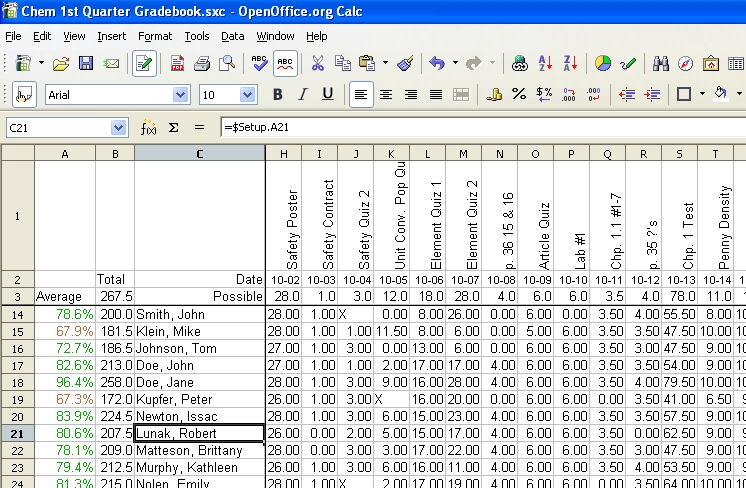
Figure 14. Frozen rows and columns.
You can set the freeze point at one row, one column, or both a row and a column as in Figure 14.
Freezing single rows or columns
- Click on the header for the row below where you want the freeze or for the column to the right of where you want the freeze.
- Select Window > Freeze.
A dark line will appear to indicate where the freeze is put.
Freezing a row and a column
- Click into the cell that is immediately below the row you want frozen and immediately to the right of the column you want frozen.
- Select Window > Freeze.
You will see two lines appear on the screen, a horizontal line above this cell and a vertical line to the left of this cell. Now as you scroll around the screen everything above and to the left of these lines will remain in view.
Unfreezing
To unfreeze rows or columns, select Window > Freeze. The checkmark by Freeze will vanish.
Splitting the window
Another way to change the view is by splitting the window - otherwise known as splitting the screen. The screen can be split either horizontally or vertically or both. This allows you to have up to four portions of the spreadsheet in view at any one time.
Why would you want to do this? Imagine you have a large spreadsheet and one of the cells has a number in it which is used by three formulas in other cells. Using the split screen technique, you can position the cell containing the number in one section and each of the cells with formulas in the other sections. Then you can change the number in the cell and watch how it affects each of the formulas.
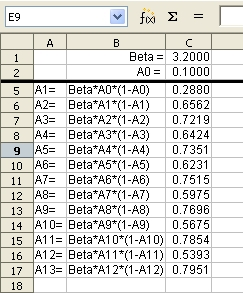
Figure 15. Split screen example.
Splitting the screen horizontally
To split the screen horizontally:
- Move the mouse pointer into the vertical scroll bar, on the right-hand side of the screen, and place it over the small button at the top with the black triangle.
- Immediately above this button you will see a thick black line (Figure 16). Move the mouse pointer over this line and it will turn into a line with two arrows (Figure 17).
- Hold down the left mouse button and a grey line will appear, running across the page. Drag the mouse downwards and this line will follow.
- Release the mouse button and the screen will split into two views, each with its own vertical scroll bar.
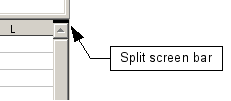
Figure 16. Split screen bar on vertical scroll bar.
[insert fig 17]
Notice in Figure 15, the 'Beta' and the 'A0' values are in the upper part of the window and other calculations are in the lower part. You may scroll the upper and lower parts independently. Thus you can make changes to the Beta and A0 values and watch their affects on the calculations in the lower half of the window.
You can also split the window vertically as described below—with the same results, being able to scroll both parts of the window independently. With both horizontal and vertical splits, you have four independent windows to scroll.
Splitting the screen vertically
To split the screen vertically:
- Move the mouse pointer into the horizontal scroll bar at the bottom of the screen and place it over the small button on the right with the black triangle.
- Immediately to the right of this button you will see a thick black line (Figure 18). Move the mouse pointer over this line and it will turn into a line with two arrows.
- Hold down the left mouse button and a grey line will appear, running up the page. Drag the mouse to the left and this line will follow.
- Release the mouse button and the screen will be split into two views, each with its own horizontal scroll bar.

Figure 18: Split bar on horizontal scroll bar.
Note: Splitting the screen horizontally and vertically at the same time will give four views, each with its own vertical and horizontal scroll bars.
Removing split views
- Double-click on each split line, or
- Click on and drag the split lines back to their places at the ends of the scroll bars, or
- Select Window > Split. This will remove all split lines at the same time.
Tip: You can also split the screen using a menu command. Click in a cell that is immediately below and immediately to the right of where you wish the screen to be split, and choose Window > Split.
Entering data into a sheet
Entering numbers
Select the cell and type in the number using either the top row of the keyboard or the numeric keypad.
To enter a negative number, either type a minus (–) sign in front of it or enclose it in brackets ( ).
By default numbers are right-aligned and negative numbers have a leading minus symbol.
Entering text
Select the cell and type the text. Text is left-aligned by default.
Entering numbers as text
If a number is entered in the format 01481, Calc will drop the leading 0. To preserve the leading zero, in the case of telephone area codes for example, precede the number with an apostrophe, like this: '01481. However, the data is now regarded as text by Calc. Formulas and functions will treat the entry like any other text entry, which typically results in it being a zero in a formula, and being ignored in a function.
Note: When entering an apostrophe to allow a leading zero to be displayed, the apostrophe will not be visible in the cell after the Enter key is pressed only if the apostrophe is a plain apostrophe (not a "smart quote" apostrophe). The type of apostrophe is selected by choosing Tools > Autocorrect > Custom Quotes. The selection of the apostrophe type will affect Calc and Writer. If "smart quotes" are selected for apostrophes, the apostrophe will remain visible in the cell after pressing Enter.
Tip: Numbers can have leading zeros and be regarded as numbers (as opposed to text) if the the cell is formatted appropriately. Right-click on the cell and choose Format Cells > Numbers. Adjust the leading zeros setting to add leading zeros to numbers.
Entering dates and times
Select the cell and type the date or time. You can separate the date elements with a slant (/) or a hyphen (-) or use text such as 10 Oct 03. Calc recognizes a variety of date formats. You can separate time elements with colons such as 10:43:45.
| Content on this page is licensed under the Creative Common Attribution 3.0 license (CC-BY). |


